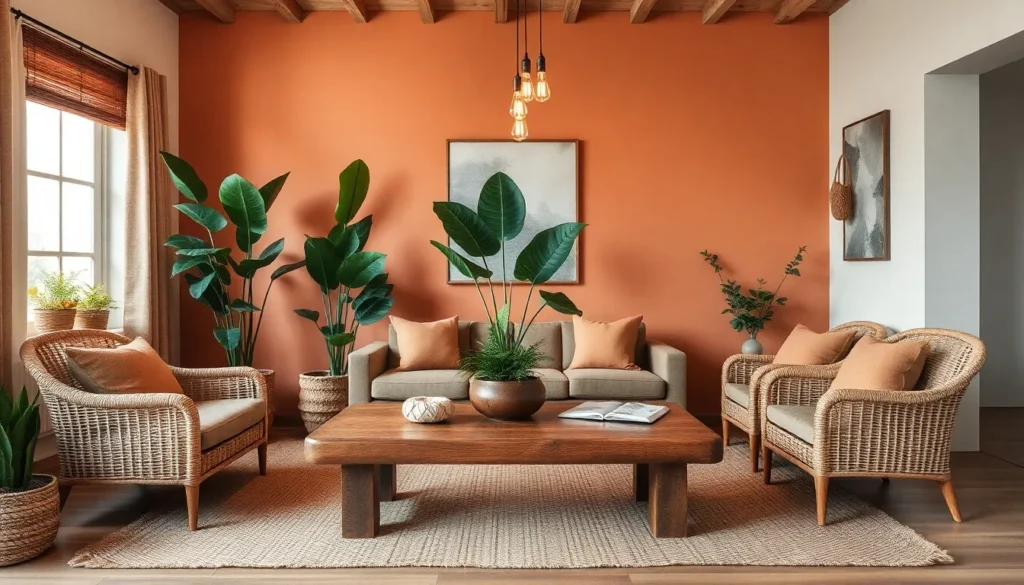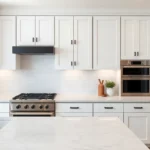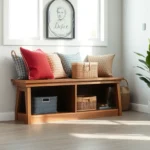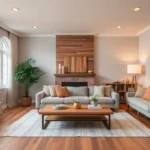We’ve all felt that irresistible pull toward spaces that feel grounded and authentic. Earthy living rooms capture this essence perfectly by bringing nature’s warmth and tranquility indoors through rich textures warm tones and organic materials.
Creating an earthy living room isn’t just about following trends—it’s about crafting a sanctuary that nurtures your well-being while reflecting your connection to the natural industry. These design choices help us slow down and appreciate life’s simple pleasures in our fast-paced digital age.
Whether you’re drawn to rustic charm with reclaimed wood accents or prefer modern earth tones with sleek natural stone features we’ll explore versatile ideas that transform any living space into a cozy retreat. From budget-friendly DIY projects to statement pieces that anchor your room these earthy design concepts will help you create the perfect balance between comfort and style.
Natural Color Palettes That Ground Your Space
Color choices form the foundation of any earthy living room design. We’ll explore three essential palette groups that create instant connection to nature’s calming influence.
Warm Terracotta and Clay Tones
Terracotta brings Mediterranean warmth into our living spaces through its rich, sun-baked qualities. We see this earthy hue working beautifully as an accent wall behind our sofa or fireplace. Clay-inspired colors like burnt sienna and rusty orange add depth when we incorporate them through throw pillows, pottery, and woven textiles.
Pairing terracotta with cream or warm white creates a balanced foundation that doesn’t overwhelm our space. We can introduce these tones gradually through artwork, ceramic vases, or handcrafted bowls displayed on our coffee table. Adobe-inspired shades work especially well in rooms with abundant natural light, where they glow with warmth throughout the day.
Rich Forest and Sage Greens
Forest greens anchor our living room with the tranquil essence of woodland retreats. We love how deep emerald or hunter green creates a sophisticated backdrop for natural wood furniture and brass accents. Sage green offers a softer alternative that pairs beautifully with our existing neutral pieces.
Olive and eucalyptus tones bring botanical freshness without the boldness of darker greens. We can layer these shades through velvet cushions, linen curtains, or a statement area rug that ties our seating area together. Pine and moss greens work particularly well when we want to create a cozy reading nook or meditation corner.
Neutral Beiges and Warm Grays
Beige serves as our versatile foundation, allowing other earthy elements to shine while maintaining visual calm. We choose warm undertones like mushroom, taupe, and oatmeal rather than cool grays that can feel sterile. These colors create a sophisticated canvas for our natural textures and wooden accents.
Greige combinations offer modern appeal while staying true to our earthy aesthetic. We layer different shades of warm gray through our upholstery, throw blankets, and decorative accessories to create visual interest. Stone-inspired hues like pebble and driftwood gray connect our indoor space to natural landscapes outside our windows.
Organic Textures and Materials for Authentic Appeal
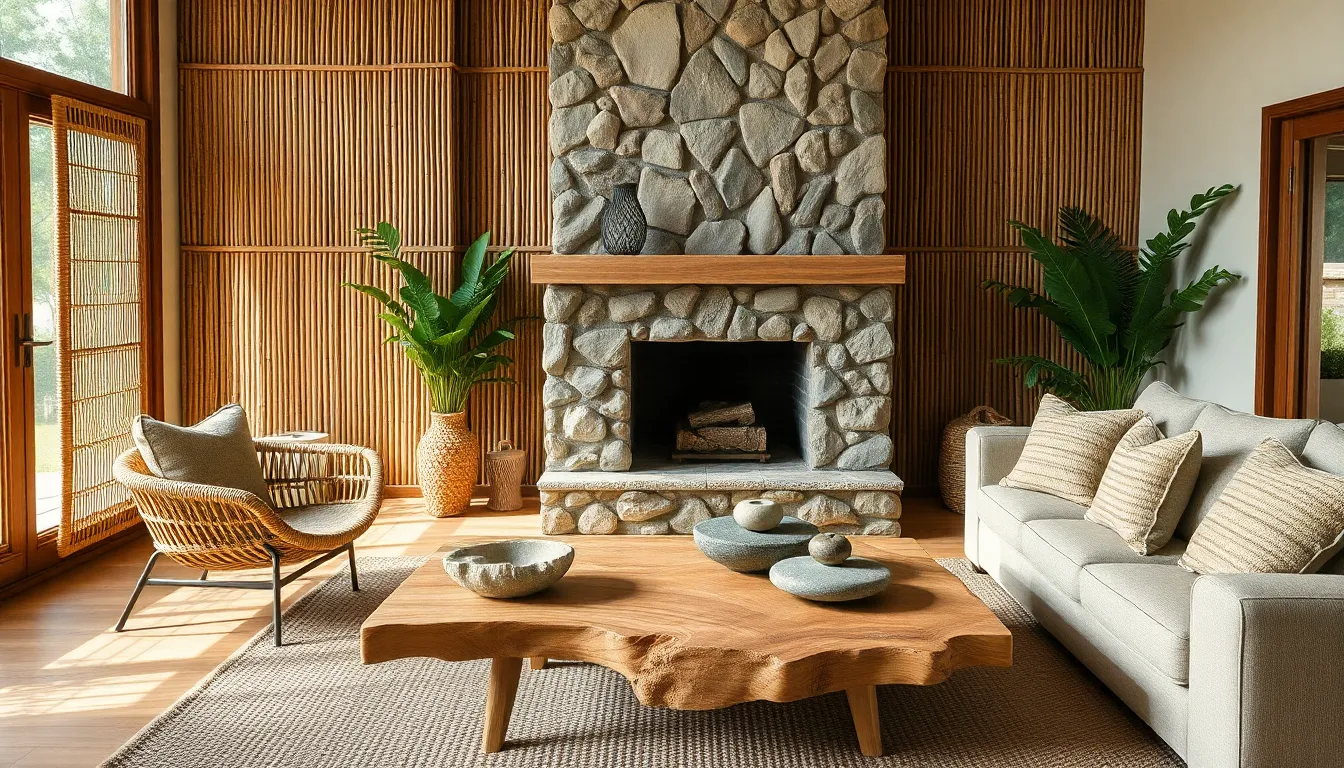
Building on our carefully chosen color palette, incorporating organic textures and materials transforms your living room into an authentic natural sanctuary. We’ll explore how different textural elements work together to create depth and visual interest while maintaining that earthy aesthetic.
Woven Rattan and Bamboo Accents
Rattan chairs bring immediate warmth and natural texture to any earthy living space. We recommend incorporating these sustainable materials through statement pieces like a rattan accent chair or woven ottoman that serves as both seating and storage. Bamboo wall panels create stunning focal points while adding vertical texture that draws the eye upward.
Bamboo baskets offer practical storage answers that blend seamlessly with your organic design theme. These versatile pieces work beautifully for organizing throw blankets, magazines, or children’s toys while contributing to the room’s natural appeal. Rattan stools provide flexible seating options that can easily move throughout the space as needed.
Natural Stone and Raw Wood Elements
Stone fireplaces serve as dramatic focal points that anchor your earthy living room design. We’ve found that natural stone veneers on accent walls create similar impact without the expense of full stone construction. Raw wood coffee tables introduce organic shapes and grain patterns that become conversation starters.
Stone bowls filled with natural elements like pinecones or dried botanicals add sculptural interest to your space. Raw wood shelves showcase your favorite books and decorative objects while reinforcing the connection to nature. Hand thrown ceramics displayed on these natural wood surfaces create beautiful textural contrasts.
Jute and Hemp Textiles
Hand woven jute rugs provide foundation warmth while defining seating areas in open floor plans. We love how these natural fiber rugs age beautifully and develop character over time. Hemp upholstery offers durability and comfort for furniture pieces that see daily use.
Jute wall hangings add vertical texture and artistic elements without overwhelming the space. Hemp throw pillows in various weaves create layered comfort on sofas and chairs. These sustainable textile choices purify indoor air naturally while contributing to your room’s authentic earthy appeal.
Plant Life Integration for Living Vibes
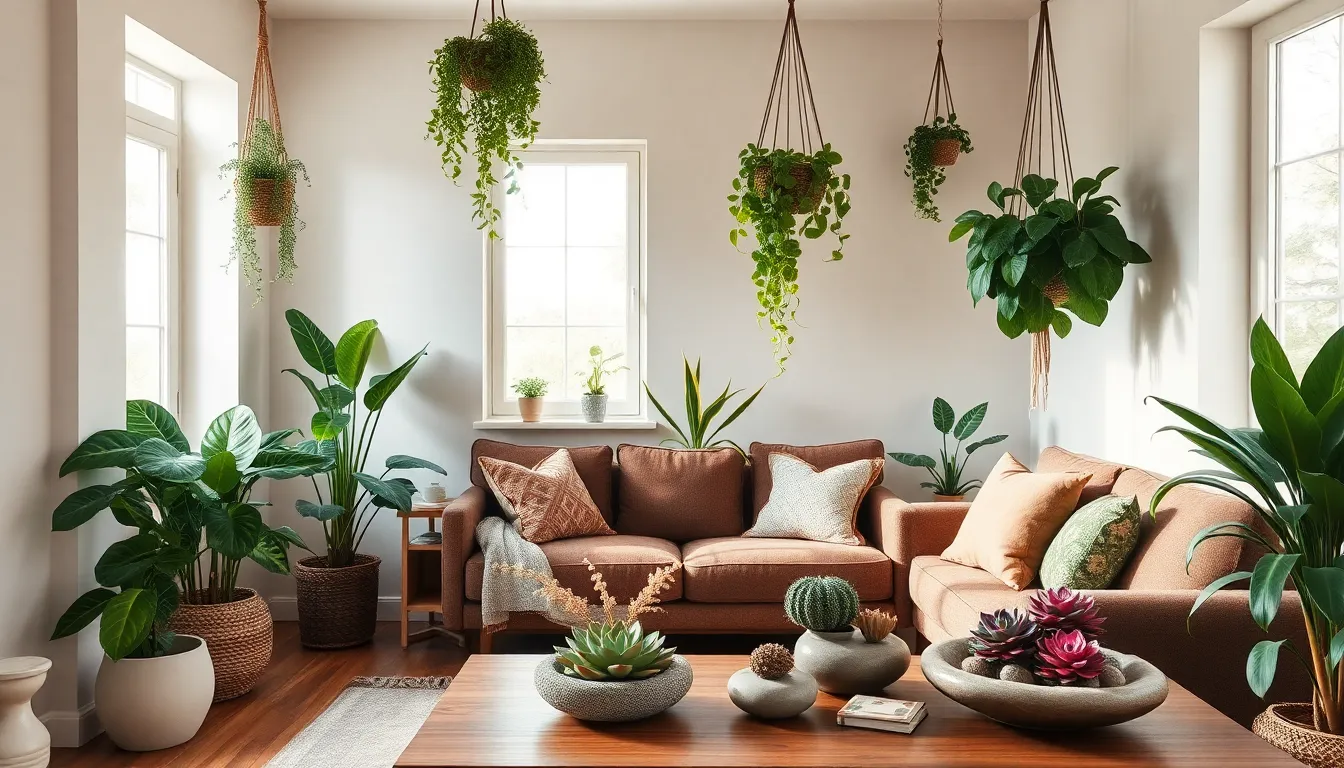
Living plants breathe life into our earthy living spaces while creating a natural bridge between indoor comfort and outdoor tranquility.
Statement Indoor Trees and Large Plants
Fiddle leaf figs command attention as towering focal points that instantly transform any corner into a botanical showcase. These dramatic specimens can reach up to 6 feet indoors and create vertical interest that draws the eye upward. Rubber plants offer another striking option with their glossy leaves and sturdy branches that complement raw wood furniture beautifully.
Floor placement near windows maximizes natural light exposure while creating defined zones within open living spaces. We recommend choosing containers that echo our earthy color palette like terracotta pots or woven baskets. Large monstera deliciosa plants add tropical flair with their distinctive split leaves that cast interesting shadows on neutral walls.
Grouping multiple large plants in varying heights creates a mini indoor forest that enhances the organic atmosphere. Snake plants and bird of paradise varieties thrive in living room conditions while requiring minimal maintenance.
Trailing Vines and Hanging Gardens
English ivy cascades gracefully from hanging planters positioned near ceiling corners or mounted on natural wood beams. These trailing beauties soften harsh architectural lines while adding movement and flow to static furniture arrangements. Pothos varieties grow rapidly and tolerate low light conditions that often challenge other houseplants.
Macramé hangers crafted from hemp rope perfectly complement our jute and natural textile elements while supporting trailing philodendrons or heart leaf varieties. We suggest hanging these gardens at varying heights to create visual depth and layered greenery throughout the space.
Wall mounted planters showcase trailing succulents like string of pearls or burro’s tail against stone accent walls. These living curtains filter natural light beautifully while maintaining the room’s connection to outdoor garden spaces.
Succulent Collections and Air Plants
Desert succulents thrive in decorative stone bowls that echo our geological accent pieces while requiring minimal water and care. Jade plants, echeveria, and barrel cacti create textural variety when grouped in clusters of three or five specimens. These hardy plants complement warm terracotta tones and add sculptural interest to coffee tables and shelving.
Air plants attach directly to driftwood or nestle into hanging glass terrariums without requiring soil or traditional planters. Tillandsia varieties absorb moisture from the air while adding unique silvery textures that contrast beautifully with rich forest greens. We love displaying these ethereal plants on raw wood mantels or floating shelves.
Succulent arrangements in handmade ceramics reinforce our connection to artisanal elements while providing year round color and form. These low maintenance collections work particularly well on window sills where morning light highlights their waxy textures and varied forms.
Sustainable Furniture Choices for Eco-Conscious Design

Creating an earthy living room extends beyond aesthetics to embrace environmental responsibility. We can build stunning spaces while supporting sustainability through thoughtful furniture selections that minimize our ecological footprint.
Reclaimed Wood Coffee Tables and Shelving
Reclaimed wood furniture transforms discarded materials into stunning focal points for our earthy living rooms. These pieces are repurposed from old buildings and urban tree management programs, diverting materials from landfills while adding unique character to our spaces. Coffee tables crafted from reclaimed wood feature distinctive grain patterns and weathered textures that tell stories of their previous lives.
Shelving units made from reclaimed materials offer both functionality and environmental benefits. The Gallery collection exemplifies this approach, using urban wood sourced from across the U.S. to create stylish and durable pieces. Each reclaimed wood shelf displays natural imperfections and variations that make every piece one of a kind.
Storage answers using reclaimed materials help us organize our living spaces while conserving natural resources. Floating shelves, bookcases, and media consoles crafted from salvaged wood bring warmth and authenticity to earthy interiors. These sustainable choices reduce demand for newly harvested timber while creating conversation pieces that guests will admire.
Vintage and Thrifted Statement Pieces
Vintage furniture extends the lifecycle of existing products while supporting the circular economy in our design choices. Thrifted armchairs, sideboards, and lamps offer timeless designs that complement earthy aesthetics without requiring new resource extraction. These pre loved pieces often feature superior craftsmanship from earlier eras that modern mass production rarely matches.
Statement pieces from thrift stores and estate sales can be refreshed with eco friendly paints and finishes. Mid century modern credenzas, antique wooden chairs, and retro lighting fixtures integrate seamlessly into earthy living rooms when updated thoughtfully. We can transform these finds into personalized elements that reflect our style while honoring their original design integrity.
Antique wooden furniture brings established patina and character that new pieces can’t replicate instantly. Vintage leather sofas, wooden trunks used as coffee tables, and aged brass lighting fixtures create authentic earthy atmospheres. These sustainable choices prevent quality furniture from entering landfills while adding distinctive charm to our living spaces.
Handcrafted Artisan Furniture
Handcrafted furniture supports local artisans while ensuring high quality pieces that last for decades. Local craftspeople use traditional techniques and sustainable materials to create furniture that minimizes environmental impact through responsible sourcing and production methods. These artisan pieces often become cherished focal points that combine exceptional craftsmanship with environmental consciousness.
Custom made furniture allows us to specify sustainable materials like FSC certified wood and low VOC finishes. The Hudson collection demonstrates this commitment, using 95% locally sourced wood within a 350 mile radius of the workshop to support regional economies and reduce transportation emissions. Artisan furniture makers often work directly with sustainable lumber suppliers to ensure responsible forest management practices.
Handcrafted pieces feature unique details and superior construction that mass produced furniture cannot match. Local woodworkers, metalworkers, and upholsterers create custom answers that fit our exact spaces while supporting small businesses in our communities. These investments in artisan craftsmanship result in heirloom quality furniture that we can pass down through generations.
| Sustainable Choice | Environmental Benefits | Design Impact |
|---|---|---|
| Reclaimed Wood | Diverts waste from landfills, reduces new timber demand | Unique character, weathered textures, conversation pieces |
| Vintage/Thrifted | Extends product lifecycle, supports circular economy | Timeless designs, superior craftsmanship, authentic patina |
| Handcrafted Artisan | Local sourcing, traditional techniques, quality construction | Custom answers, community support, heirloom quality |
Natural Lighting Solutions That Enhance Earthiness
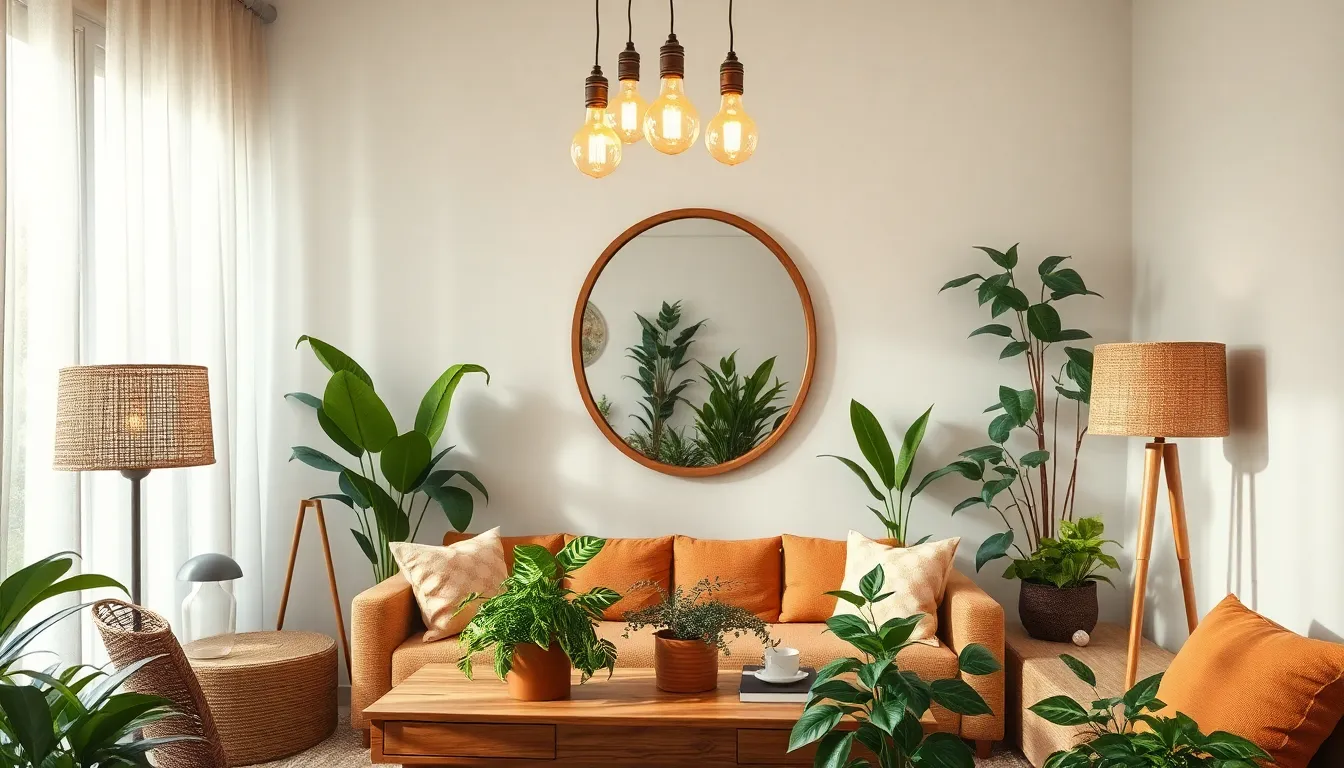
Lighting sets the foundation for any earthy living room design. We’ll explore three key approaches that bring natural warmth and organic appeal to your space.
Warm Edison Bulb Fixtures
Edison bulbs with exposed filaments instantly transform lighting from purely functional to romantically rustic. These bulbs emit a warm glow that complements earthy color palettes like terracotta and sage green. We recommend choosing fixtures that showcase the vintage style filaments, whether in pendant lights above seating areas or table lamps beside reclaimed wood furniture.
Pendant fixtures featuring Edison bulbs work exceptionally well over dining spaces or kitchen islands. The exposed filament design adds visual interest while casting gentle shadows that enhance natural textures like woven rattan and raw wood. Table lamps with Edison bulbs create intimate reading nooks when paired with hemp upholstery or jute textiles.
Industrial style fixtures complement the rustic charm of Edison lighting perfectly. Black metal frames or weathered bronze finishes echo the organic materials found throughout earthy spaces. We’ve found that mixing different Edison bulb shapes creates ever-changing lighting layers that support both ambient and task lighting needs.
Organic Lampshade Materials
Woven fiber lampshades bring tactile warmth that synthetic materials simply can’t match. Natural materials like rattan, bamboo, and seagrass filter light beautifully while adding another layer of organic texture to your room. These lampshades pair seamlessly with statement indoor trees and succulent collections.
Linen lampshades offer versatility in neutral beiges and warm grays that ground your lighting choices. The natural fabric texture diffuses light softly, creating the gentle ambiance that makes earthy living rooms so inviting. We particularly love how linen shades complement handcrafted artisan furniture and vintage pieces.
Jute and hemp materials provide durability while maintaining the authentic natural aesthetic. These robust fibers withstand daily use while contributing to the sustainable design philosophy of earthy interiors. Hand woven options add unique character that mass produced shades lack, supporting the artisan crafted elements throughout your space.
Maximizing Natural Window Light
Sheer curtains allow maximum daylight penetration while maintaining privacy and softness. Natural linen or cotton sheers filter harsh sunlight into gentle illumination that enhances the warm terracotta and clay tones in your color palette. We recommend choosing neutral colors that won’t compete with your carefully selected earth tones.
Bamboo blinds provide adjustable light control with authentic organic appeal. These window treatments complement other bamboo accents like wall panels while offering practical light management throughout the day. The natural texture adds vertical interest that works beautifully with trailing vines and air plants near windows.
Strategic mirror placement amplifies natural light while reflecting your plant collections and natural stone elements. We position mirrors opposite windows to bounce light deeper into the room, illuminating raw wood coffee tables and geological accents like agate coasters. This technique doubles the impact of your natural lighting while showcasing the organic textures that define earthy living spaces.
Decorative Elements That Connect to Nature
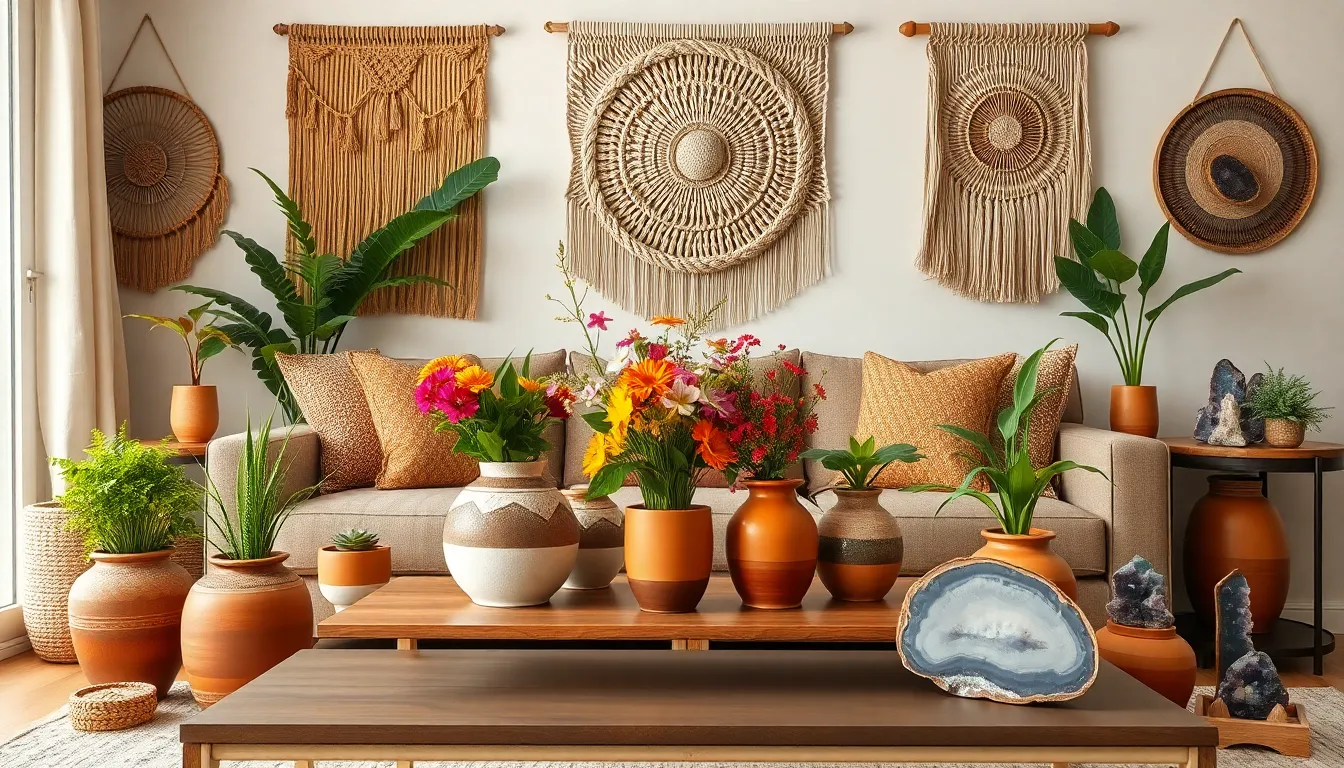
Building on our foundation of natural lighting and sustainable choices, we can deepen our connection to the earth through carefully selected decorative elements. These organic accents transform our living rooms into authentic natural sanctuaries that reflect the beauty of the outdoors.
Ceramic and Pottery Accents
Ceramic vases filled with branches or fresh flowers create stunning natural focal points throughout our earthly living spaces. We recommend displaying handcrafted pottery pieces that add warmth and cultural depth while showcasing the artisan’s connection to traditional techniques. Hand-thrown ceramics bring unique character to coffee tables and shelving units, with each piece telling its own story through subtle imperfections and organic shapes.
Terra cotta planters serve dual purposes by housing our favorite greenery while contributing rich clay tones that complement our earthy color palette. We find that mixing different pottery sizes and textures creates visual interest without overwhelming the space. Glazed ceramic bowls work beautifully for holding decorative stones, potpourri, or seasonal elements like pinecones and acorns.
Natural Fiber Wall Hangings
Woven wall hangings made from cotton or wool fibers instantly create a cozy atmosphere that softens hard surfaces and adds textural depth. We love incorporating macrame pieces that showcase intricate knotwork while maintaining the organic aesthetic we’re cultivating. Jute tapestries provide rustic charm and work particularly well behind seating areas or as statement pieces above mantels.
Linen wall art offers subtle sophistication while maintaining our natural theme through its breathable, organic texture. We suggest mixing different fiber types and weaving techniques to create layered visual interest. Hemp wall hangings contribute durability and sustainability while adding unique texture patterns that catch and filter natural light beautifully.
Stone and Crystal Displays
Geode and mineral accents bring geological wonder directly into our living spaces through their natural crystalline formations and earthy color variations. We recommend incorporating agate coasters that protect surfaces while showcasing nature’s artistic patterns in blues, greens, and warm earth tones. Quartz bookends serve practical purposes while adding sophisticated sparkle that catches both natural and artificial light.
Crystal clusters displayed on floating shelves or coffee tables create conversation pieces that reflect our connection to the earth’s ancient processes. Amethyst formations work particularly well in earthy living rooms, offering deep purple hues that complement sage greens and warm clay tones. We find that grouping different sized stones and crystals in ceramic bowls creates compelling vignettes that invite closer examination and touch.
Flooring Options That Embrace Earth Tones
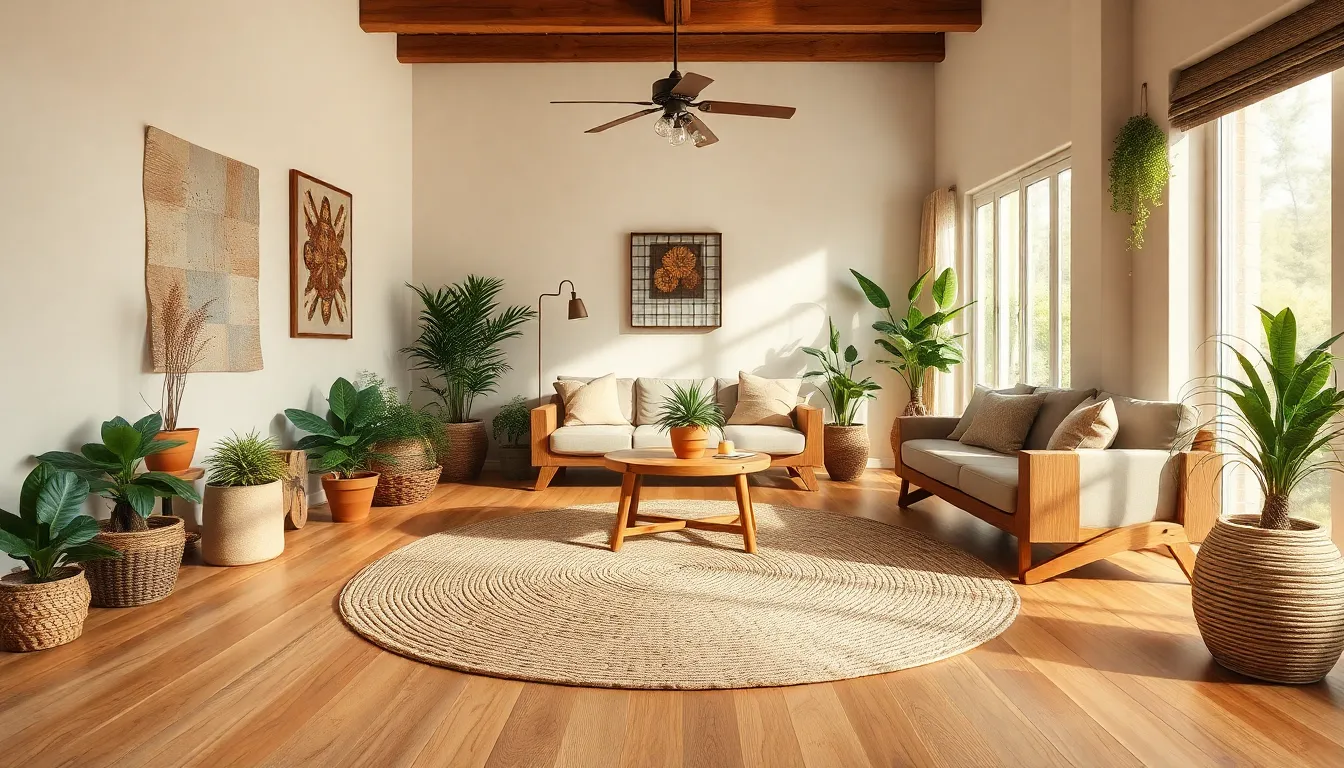
The foundation of any earthy living room starts beneath our feet. We’ll explore three distinctive flooring approaches that anchor your space in nature’s warm embrace.
Natural Hardwood in Warm Stains
Natural hardwood flooring with warm stains creates an instantly welcoming foundation for our earthy living rooms. Oak and walnut options deliver rich, organic patterns that naturally complement the terracotta and sage green palettes we’ve established throughout the space.
We recommend choosing floors with visible grain patterns that showcase the wood’s natural character. These authentic textures add depth while providing a perfect backdrop for our sustainable furniture pieces and ceramic accents. Warm honey oak tones pair beautifully with jute textiles, while deeper walnut stains enhance the dramatic appeal of raw wood coffee tables and stone displays.
Professional installation ensures these floors will support our heavy statement plants and artisan furniture for decades to come. The natural variation in wood grain means each plank tells its own story, reinforcing that connection to nature we’re cultivating throughout the room.
Organic Area Rugs and Floor Coverings
Organic area rugs made from natural fibers transform hardwood foundations into cozy gathering spaces. Jute rugs provide excellent texture that complements our woven rattan accents and handcrafted pottery collections perfectly.
Sisal options offer durability for high traffic areas while maintaining that authentic earthy appeal. These natural fibers age gracefully, developing character that enhances rather than detracts from our carefully chosen color schemes. Wool rugs bring unmatched warmth and softness, creating comfortable seating areas around our stone fireplaces and reclaimed wood furniture.
We suggest layering different sized rugs to define distinct zones within open living spaces. Hand woven pieces support artisan communities while adding unique textures that can’t be replicated by machine production. Natural fiber rugs also provide acoustic benefits, softening sounds in rooms with stone elements and bamboo wall panels.
Stone and Tile Alternatives
Stone and terracotta tiles deliver authentic earthy vibes that perfectly complement our Mediterranean inspired color palettes. These natural materials create stunning visual depth while providing practical durability for our plant filled sanctuaries.
Terracotta tiles bring warm clay tones that echo our ceramic vase collections and pottery accents beautifully. Their natural variation in color and texture creates visual interest without overwhelming the space. Stone options like slate or travertine add sophisticated neutral foundations that allow our forest green plants and warm wood elements to truly shine.
We find these materials particularly effective in creating seamless transitions between indoor and outdoor spaces. Their natural temperature regulation properties keep rooms comfortable year round, while their low maintenance requirements suit our sustainable lifestyle goals. Stone and tile surfaces also provide stable foundations for our heavier decorative elements like geode displays and large succulent collections.
Budget-Friendly Ways to Achieve Earthy Living Room Ideas
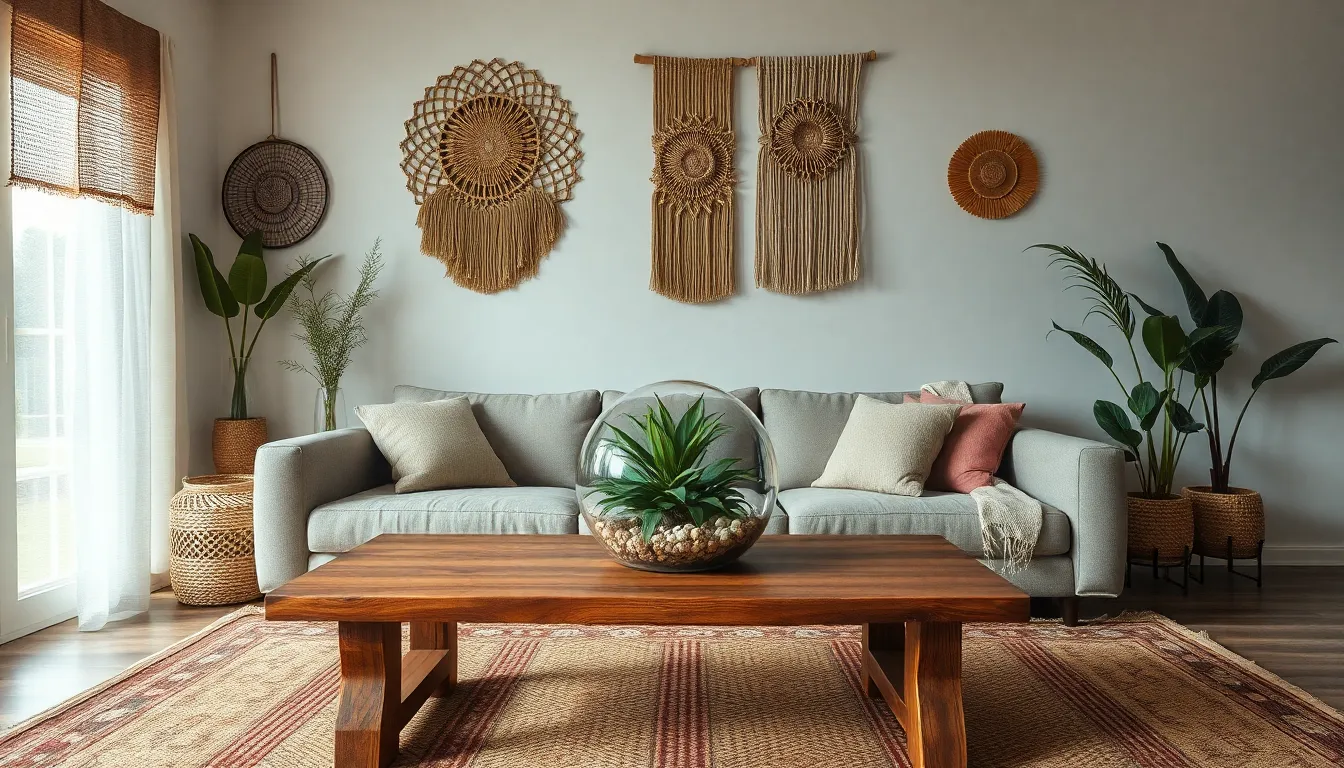
Creating an earthy living room doesn’t require a massive renovation budget. We’ll show you practical approaches that transform your space while keeping costs manageable.
DIY Natural Decor Projects
Terrariums become stunning focal points when we fill glass containers with soil, plants, and small rocks for mini indoor gardens. These living displays complement our existing stone and crystal elements while adding fresh greenery to shelves and coffee tables.
Woven wall hangings offer artistic texture using natural fibers like cotton or wool to create abstract wall art. We can create these pieces to echo the warm color palettes we’ve established, incorporating terracotta and sage tones through varied thread choices.
Stone arrangements create conversation pieces when we gather decorative stones or shells in attractive patterns on tables or shelves. These displays connect perfectly with our geode and mineral accents, reinforcing the natural sanctuary aesthetic without any purchase cost.
Affordable Plant Propagation
Seed sharing expands our plant collection through exchanges with friends or neighbors to acquire new species. This community approach aligns with our sustainable furniture philosophy while building diverse greenery for our earthy spaces.
Cuttings multiply our existing plants by replanting cut stems in soil to create new growth. We can propagate our trailing vines like pothos and English ivy, expanding coverage areas around our reclaimed wood furniture pieces.
Local nurseries provide budget options for finding affordable plants that complement our established indoor forest zones. These community resources often offer seasonal sales on fiddle leaf figs and rubber plants perfect for statement corners.
Thrift Store Treasure Hunting
Vintage furniture transforms with natural finishes when we refurbish old pieces to fit our earthy theme. We can apply earth tone stains to wooden tables and chairs, creating unique pieces that rival expensive reclaimed wood furniture.
Natural fiber rugs enhance comfort through affordable options like jute or sisal found at secondhand stores. These discoveries provide the same textural benefits as new organic area rugs while supporting our circular economy approach.
Unique decor items add character through finds like vintage planters or natural stone vases that perfectly complement our ceramic and pottery accents. Thrift stores often house handcrafted pieces with the same artisan quality we value in sustainable design choices.
Conclusion
Creating an earthy living room transforms our home into a peaceful sanctuary that nurtures both body and soul. We’ve explored how thoughtful combinations of natural materials textures and sustainable choices can achieve this timeless aesthetic without very costly.
The beauty of earthy design lies in its flexibility – whether we’re starting fresh or updating existing spaces these nature-inspired elements work harmoniously together. From statement plants to reclaimed furniture each piece contributes to a cohesive environment that celebrates our connection to the natural industry.
We’re confident that implementing these earthy living room ideas will help create a space where we can truly unwind and recharge. The result is more than just beautiful decor – it’s a living space that reflects our values and enhances our daily well-being.
Frequently Asked Questions
What is an earthy living room style?
An earthy living room style brings nature indoors through warm color palettes, organic materials, and natural textures. It features elements like reclaimed wood, natural stone, woven fibers, and earth-toned colors such as terracotta, sage green, and warm beiges. This design approach creates a tranquil, cozy atmosphere that fosters well-being and connection to nature.
What colors work best for an earthy living room?
The best colors for an earthy living room include warm terracotta and clay tones, rich forest and sage greens, and neutral beiges with warm grays. These colors create a calming foundation that mimics nature’s palette. Use terracotta for Mediterranean warmth, greens for tranquility, and neutral tones as versatile bases that allow other earthy elements to shine.
How can I incorporate natural textures in my living room?
Incorporate natural textures through woven rattan furniture, bamboo wall panels, natural stone fireplaces, and raw wood coffee tables. Add jute rugs, hemp upholstery, and organic textiles for comfort. These materials create depth and visual interest while reinforcing your connection to nature, transforming your space into an authentic natural sanctuary.
What plants work best in earthy living rooms?
Statement indoor trees like fiddle leaf figs and rubber plants create dramatic focal points and vertical interest. Trailing vines such as English ivy and pothos add movement and flow. Low-maintenance succulents and air plants displayed in stone bowls or hanging terrariums provide unique textures while requiring minimal care and enhancing the natural aesthetic.
How can I achieve an earthy living room on a budget?
Create DIY natural decor like terrariums, woven wall hangings, and stone arrangements. Propagate plants from seeds or cuttings to expand your collection affordably. Hunt for vintage furniture and unique decor items at thrift stores that can be refurbished to fit your earthy theme. These budget-friendly approaches maintain sustainability while creating your natural sanctuary.
What lighting works best for earthy living rooms?
Use warm Edison bulb fixtures for cozy illumination and organic lampshades made from woven fibers or linen. Maximize natural light with sheer curtains and bamboo blinds for soft, adjustable lighting. Place mirrors strategically to amplify natural light and reflect organic elements. This creates a warm, inviting atmosphere that complements your earthy color palette.
What flooring options complement an earthy living room?
Natural hardwood with warm stains like oak and walnut creates a welcoming foundation. Organic area rugs made from jute or sisal add comfort and define spaces. Stone and terracotta tiles provide durable alternatives that echo the earthy aesthetic. These flooring choices reinforce your connection to nature while creating a cohesive, inviting environment.
What sustainable furniture choices work for earthy living rooms?
Choose reclaimed wood furniture that transforms discarded materials into unique, character-rich pieces. Invest in vintage and thrifted items to support the circular economy while finding timeless designs. Select handcrafted artisan furniture that supports local makers and offers superior quality. These sustainable choices minimize environmental impact while enhancing your earthy aesthetic.

